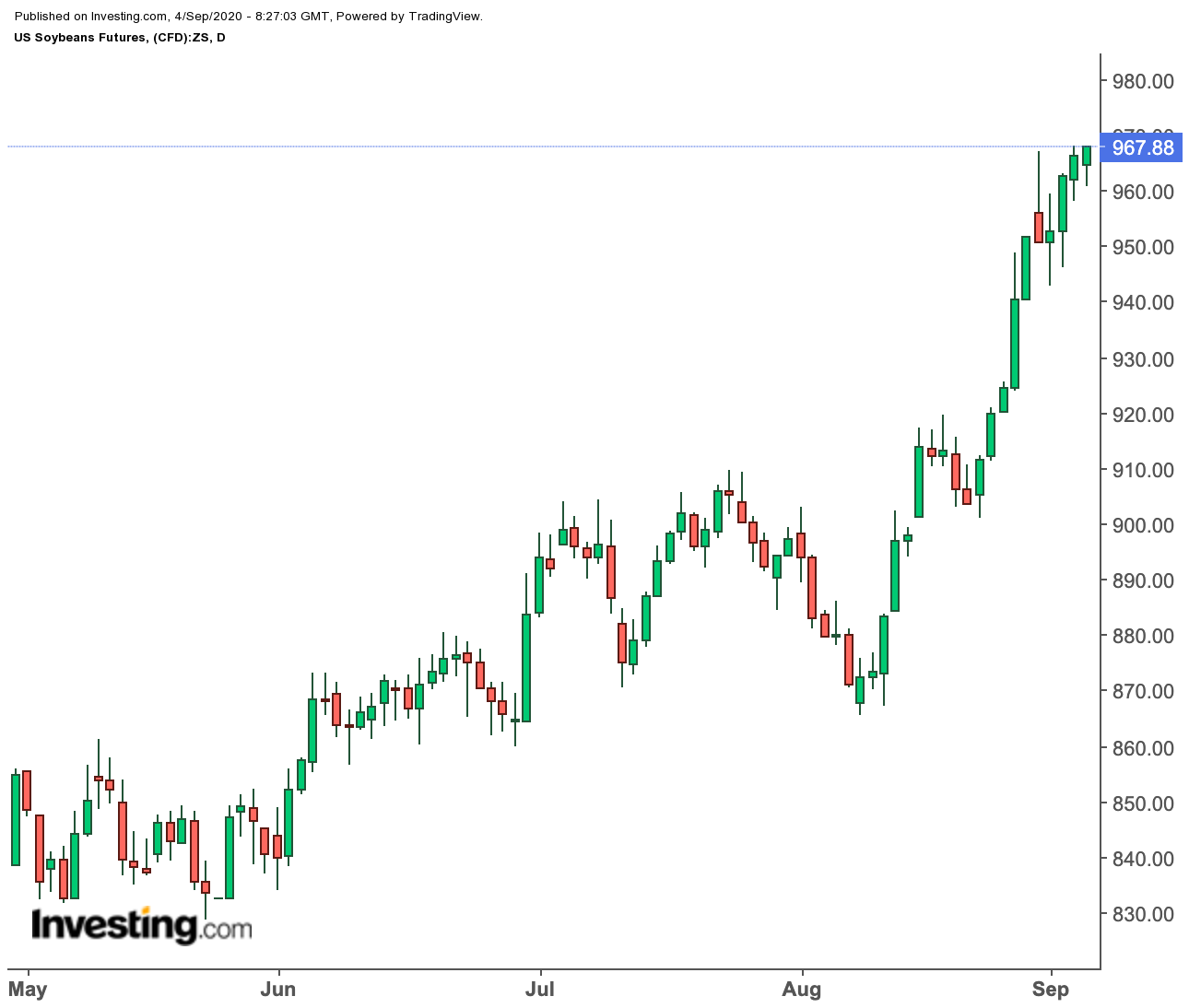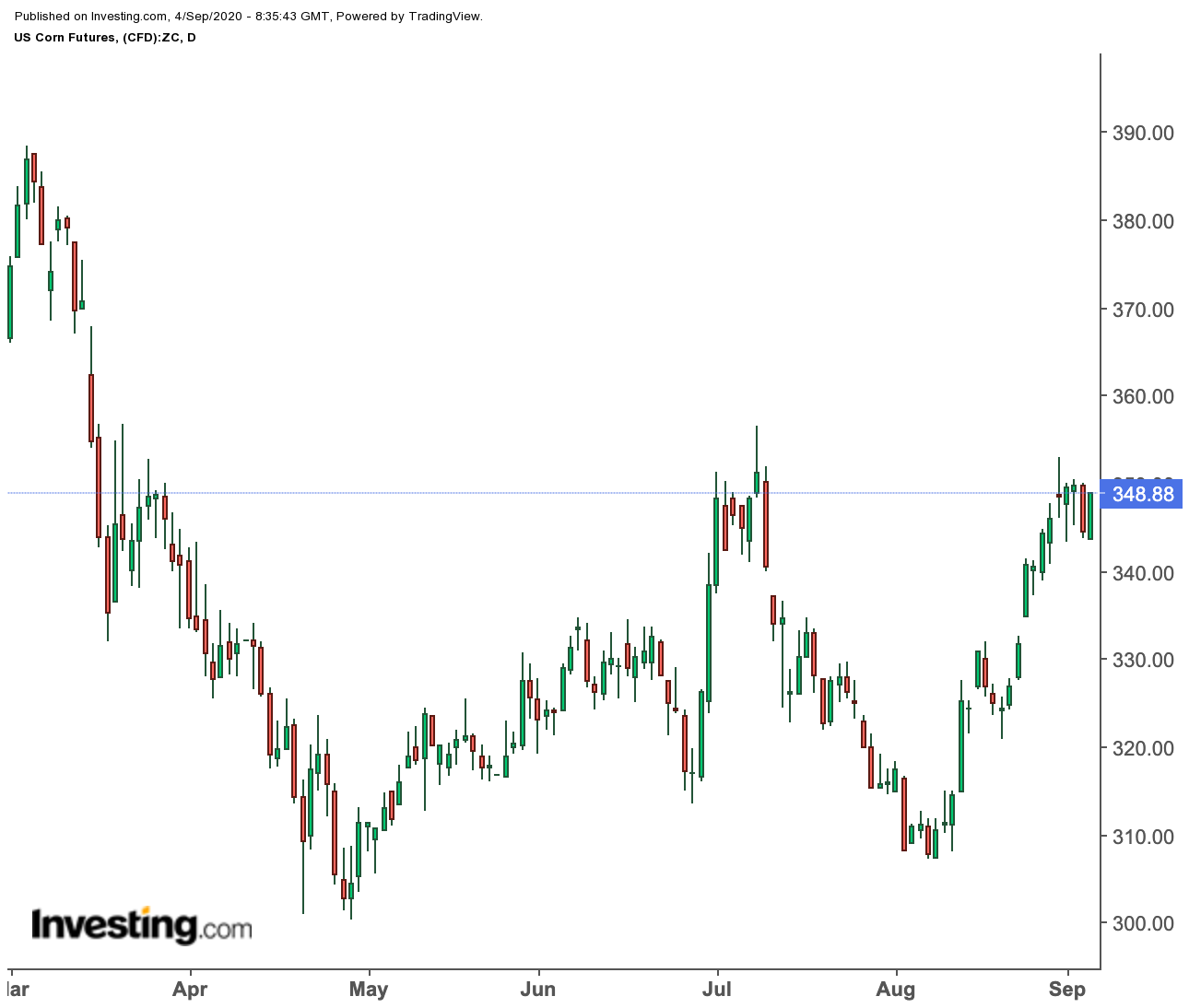While the majority of the commodities trading world huffed and puffed over this week’s renewed slump in gold and oil prices, bulls in one sector were quietly killing it: ags.
Soybeans and wheat have been the toast of the agricultural markets for four straight weeks. They're now in a rally that began sometime at the midyear.

This week particularly, macroeconomic forces catapulted the dollar and gutted precious metals and crude along with stocks, with the Dow, {8839|S&P 500}} and NASDAQ all down, amid worries that the U.S. economic recovery from the coronavirus was stalling.
Yet, grains such as soy and wheat took little hit in that crossfire, shielded by strong sales to China, among others. Corn was the exception, though it had rallied 10% in August alone—double that of soy and more than quadruple the gains in wheat.
Export Sales “That Did Not Disappoint”
Export sales were expected to be large this week for both corn and beans, and they “did not disappoint,” according to Dan Hueber, author of ‘The Hueber Report’, a daily analysis on grains issued out of St. Charles, Illinois.
“Corn was by far the leader,” Hueber said, referring to total sales of 2.5 million metric tonnes, of which 1.5 million involved clearance of old crops from inventory, with 72,000 tonnes particularly going to China.
It was a similarly euphoric story with soybean exports data released by the U.S, Department of Agriculture, Hueber said.
China Sniffing Around For More U.S. Soybeans
Hueber said:
“Bean bulls found inspiration as rumors began to circulate that China was snooping around the bean counter again and had room in the cart for a few hundred thousand metric tons,”
“It turns out that was correct as the USDA did confirm that China got to the checkout line with 132,000 metric tonnes, and right behind them was someone who could not be identified, with an additional 318,000. All this has been enough to lift bean futures into slightly higher highs for the swing.”
Corn futures in Chicago were down 0.3% for the week, after a 10% rally in August. At $3.45 per bushel, Investing.com has a “Strong Buy” recommendation on U.S. corn, projecting a near-term resistance of $3.55.
“Much of the U.S. Corn Belt will stay completely dry between Friday and Monday, per the latest 72-hour cumulative precipitation map.” Ben Potter of Farm Futures in a blog post that reinforced the market’s fundamentals.
For soybeans and wheat, the outlook was vastly better.
Chicago-traded soybean futures were up 1.6% for the week, rising for a fourth week in a row. Since the end of May, soybeans have rallied 15% in all.
At $9.67 per bushel, Investing.com also has a “Strong Buy” call on U.S. soybeans as well, projecting a near-term resistance of $9.80.
Potter added:
“Soybean export sales are transitioning quickly toward the upcoming 2020/21 marketing year, turning in just 3.2 million bushels in old crop sales, while new crop sales climbed to 64.8 million bushels, for a total of 68 million bushels.”
“That was good enough to make it to the upper end of trade estimates, which ranged between 36.7 million and 69.8 million bushels.”
Wheat futures in Chicago, meanwhile, hover at $5.53 per bushel. They were up 2.6% for the week, posting a fourth straight week of gains just like soybeans. Since the end of June, wheat has gained almost 13%.
While total wheat sales in the 2020/21 marketing year had fallen slightly behind the 2019/20 pace, with 104.7 million bushels, they were still on track with industry estimates, said Potter.
“Wheat export sales drifted 23% below last week’s tally but stayed 4% above the prior four-week average, with 21.5 million bushels,” he said. “That was also good enough to stay on the high end of trade guesses, which ranged between 12.9 million and 22.0 million bushels.”
Investing.com has a “Strong Buy” as well on U.S. wheat, projecting a near-term resistance of $5.70.

